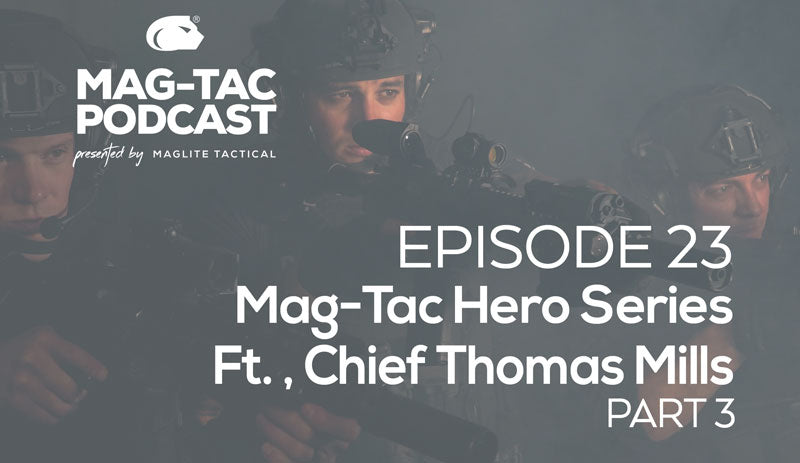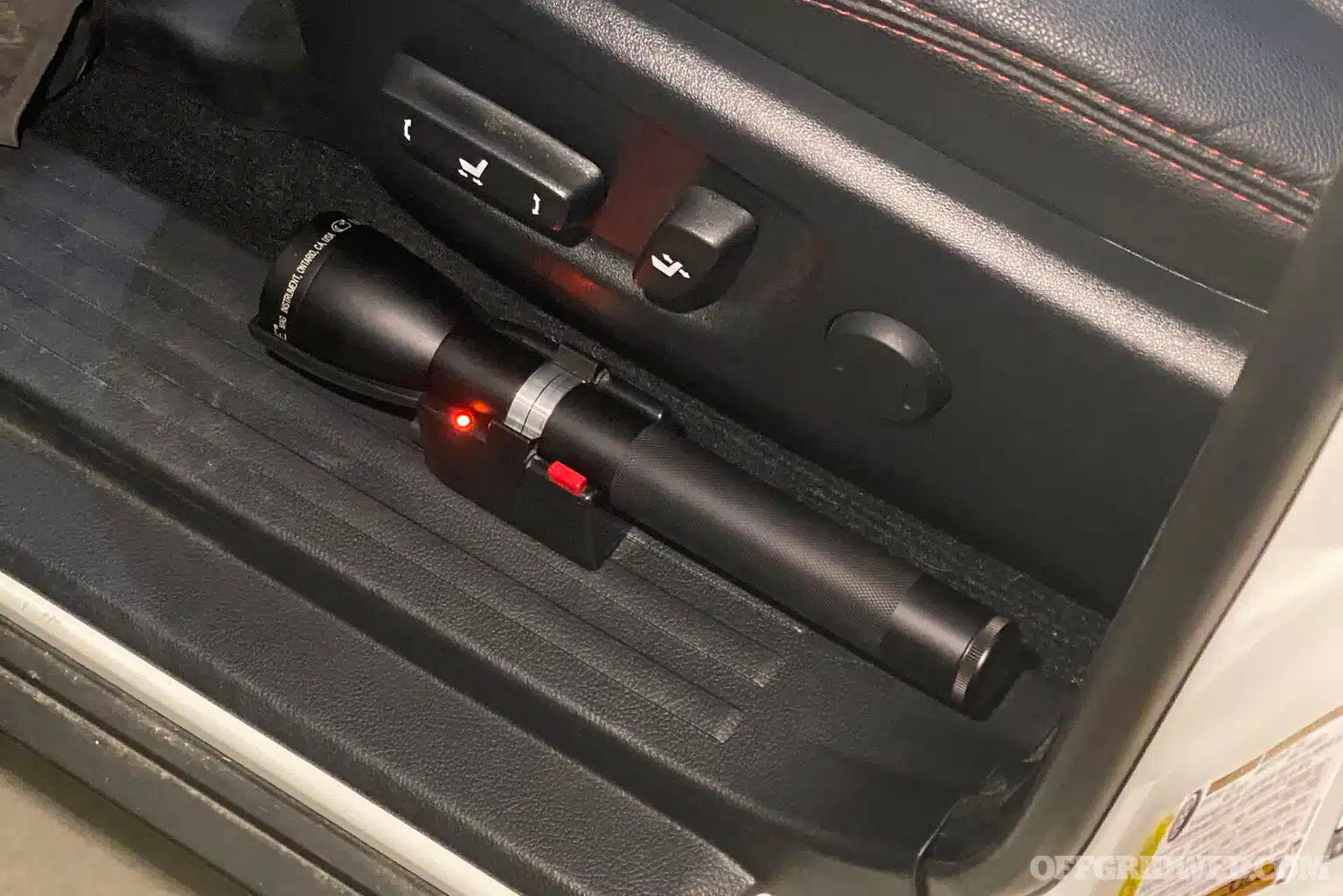Podcasts
Episode 22: Chief Thomas Mills - Maglite HERO SERIES - PART 2
A horrific fast moving fire is ripping through a row of townhomes with people trapped inside. Chief Mills must manage this crisis with a team of all volunteer firefighters including a rookie who has never seen a live fire. The race is on to put out the fire and stay alive themselves. Transcript: Producer: Welcome to the MAGTAC Hero Series with your host, Lou Desmond. Join Lou as he talks with honored hero, Chief Thomas Mills of the North Beach Maryland Volunteer Fire Department. Let's join Lou and Chief Mills to hear the first part of this heroic story. Lou Desmond: So the reason that we were there was to give you an award for being a firefighter hero in the aftermath of a horrible incident that happened in your town. This fire that came out of nowhere, swept through several townhouses, killed two civilians, and almost killed a couple of your volunteer firefighters. Can you start from the beginning and just tell us the story of that day, Chief Thomas Mills, please? Chief Thomas Mills: Yes, sir. Wednesday, April 3rd, 2019, approximately 4:00 in the afternoon, I was at the boatyard, which, I am a charter boat captain for my full-time job, I fish for a living, and I had just finished painting my boat, and I went to get some lunch. And as I was walking into the restaurant and I sat down, and when I walked in to sit down, one of the guys from the boatyard called me and I was like, "Oh, what's he want? I must've left something out." So I answered the phone and he says, "Chris," he goes, "you guys ever going to put this fire out over here by the boats?" And I was like, "Well, Bobby, what are you talking about?" He said, "The apartments and the townhouses are all on fire." I said, "Come on, man. I literally just left." It wasn't 10 minutes. Chief Thomas Mills: So I walked out the door of the restaurant and I looked in the direction of the boatyard, and I seen a large column of black smoke and I was like, "Holy cow." Well, knowing that we didn't have too many drivers that day, I knew I had to come to the firehouse and drive the apparatus, so I pulled up on the front ramp, and as I was pulling up on the front ramp, the county 911 center was dispatching the call. When I came up to the front doors, one of the young kids had the door open for me, and I told him, I said, "Look," I said, "do yourself a favor and get dressed now, both of you." I said, "Because it's one fire. There's no doubt about it." Chief Thomas Mills: So we got in the firetruck, I waited for them to get dressed. We got going down the road, it's less than a mile, I think it's like three tenths of a mile from the station. Lou Desmond: Yeah, that whole town is like five miles long on that main drag. Chief Thomas Mills: Yeah. So I made a right onto the main drag into the development, it was in between a water park and a convenience store, and the smoke was so bad, the wind was blowing 30 plus miles an hour that day, and the smoke was so bad that I literally had to slow down to less than 10 miles an hour to get down the main road because of all the cars and people that were running around and the cars were trying to get out of there. So when I pulled into the complex, I told the young man that was riding in the seat, I said, "No need for you to talk on the radio." I said, "Danny's already give a size up." Which is my safety officer. He was over at the boatyard working on his boat, so he was there rather quickly. I said, "We're going to lay out here at this hydrant." I said, "I'm going to pull down here." Chief Thomas Mills: So we laid out, I pulled down. Well, in the midst of pulling down, there was a couple gentlemen, they pushed a car out of a parking spot that was broke down in the middle of the road and hindered me from getting past the townhouses for my game plan, so it threw a little monkey wrench in there, so I kind of beached the wagon, or the engine you guys would call it, off to the left so I could leave room for the tower ladder to get in there. And I noticed the main townhouse that was fully engulfed had separated four feet from the other three townhouses that were in a row. There were four to a row, and the end unit had started to separate already by about four feet. Chief Thomas Mills: And about that time, the control center, the dispatch center called back and said, "Hey, we have a lady on the phone. Her and her granddaughter are in the bathroom." And she give us the address, which turned out to be the end unit that was fully engulfed. So when I exited the firetruck, I helped the young-ins stretch the line, came back, I grabbed my three inch, hooked it up, I charged their line, and in the midst of me charging the line, the end townhouse started to come away from the rest of the townhouses. Chief Thomas Mills: So about a minute into the whole incident, there's a gentleman standing behind me on my back and he kept yelling, "No! The people are in the second unit! The second unit!" Which would have been the unit next to the one that was pulling away. Well, Safety Officer Morrison, who is a very experienced firefighter and he's a career fireman in Prince George's County, Maryland, I went directly to him and I said, "Danny," I said, "there's a couple people trapped in there. This guy's telling me they're in that unit there." I said, "You're going to have to use best judgment. If you can go in and try to get them, that would be great." And I left it up to him, and him and one of the young gentlemen that were on the piece, Max Andrusi, who was wet behind the ears, never been on a fire, I don't think he's ever put a Scott bottle on in a real situation. Lou Desmond: Wait, wait, wait, wait. So this massive townhouse fire, wind's blowing 30, 40 miles an hour, everything's getting engulfed, you're all volunteers and this kid has zero experience in live fire and he's got to jump into it? Chief Thomas Mills: Yeah. Well, no, he's been through our academy- Lou Desmond: Well, the academy, but you said not a live fire like this. Chief Thomas Mills: He's never had a live burn like this. Producer: How will the rookie, Max, handle his first live fire? Chief Thomas Mills continues his amazing story on the next episode of The MAGTAC Hero Series.
Learn moreEpisode 21: Chief Thomas Mills - Maglite HERO SERIES - PART 1
How do you get people to volunteer to risk their own lives to save others? Meet Chief Thomas Mills our Maglite Firefighter Hero of the North Beach Volunteer Fire Department in Chesapeake Beach Maryland. Transcript: Welcome to the MAGTAC Hero Series with your host Lou Desmond. Join Lou as he talks with honored hero Chief Thomas Mills of the North Beach, Maine Volunteer Fire Department about his job, his career, and the heroic story behind the reason for this special honor. Lou Desmond: I had the great pleasure to be in a beautiful place called Chesapeake Beach, Maryland. One of the prettiest little coastal cities you'll ever want to see. And I was honored to be there to honor the gentleman who is joining us here on the podcast. And that is Chief Thomas Mills of the North beach Volunteer Fire Department. Chief Mills, thank you for being here. Chief Thomas Mills: Thank you for having me. Lou Desmond: I got to tell you, it was one of the nicest places I've ever been. I travel all over the country for Maglite giving out these firefighter hero, law enforcement hero, civilian hero awards that we do. And it was just a thrill to be there. Your city is a wonderful place, but the thing that shocked me is the fact that your fire department serving that region is an all volunteer fire department. Now when we think of volunteer fire departments, we think, oh well that went out with the civil war. That's the last time we had those, people running down the street with buckets of water in their hands. That was the volunteer fire department in people's minds. But in your town, that's what it is. Can you explain why that is, how that is and how people serve, take your time. Chief Thomas Mills: Oh absolutely. So Calvert County in a whole, which is the County that we sit in. We're in a Northern end of Calvert County. We have been all volunteer in the County since the mid 20s I believe it was. I think 1926 is when the fire department was formed. And ever since then we've been all volunteer. It's a strong community. Everybody enjoys helping each other and the whole county in general, the volunteer service is very strong here. So we have a lot of pride and it saves our taxpayers quite a bit of money. Lou Desmond: I for many years lived in Southern California and in many of the cities in Southern California, their two highest costs are their police department and their fire department and there are cities like Rancho Cucamonga or city of Ontario in inland Southern California where it seems like there's a firehouse every other block. And the cost of maintaining those things is enormous. Now I have no problem paying for firefighters and police. I think you guys do incredible work. You risk your lives, you deserve to be well paid yet your operation, these are all people volunteering their time like the guy next to you, John Tippett. How do you get people to do this for no pay? Chief Thomas Mills: Well here in Calvert County and in the state of Maryland itself, we have what's called a length of appreciation award. We call it LOSAP. So after 25 years of active service, which you have to meet a certain criteria for that, it's not very hard to do, it's broken down into four to six different categories. And if you get enough points in each category, you're awarded the points for that year. And once you accumulate 25 years and you reach the age of 52 you get a stipend every month. I think Calvert County right now is up over $650. Most of the counties around us are either just below us or just below the 600 mark. Also, too here in Calvert County, we offer a free college tuition to any of the people that join that are interested in going to college. We have a property tax program here in the County. If you're an active member and you meet your LOSAP for the year, the County will pay up to $2,500 of your property tax. Lou Desmond: Well all that's great, but I just got to tell you, your County is getting a better deal than any County or city I know of in the entire state of California where I used to live because the firefighters, they're are all making a hundred grand a year, normal time and then doing overtime and some of them are making, almost close to $300,000 a year. It's just kind of crazy. But here's what I want to point out. I was there in your wonderful town. I met a lot of great people and I just want to point out one story. There's a guy who works as a correctional officer doing overnights and that's got to be a difficult, gut wrenching, physically demanding, mentally demanding job. And then on his off days he's volunteering as a volunteer firefighter. Who is that guy? Chief Thomas Mills: His name was Jack [Sulewski]. That was the gentleman you were talking to. Lou Desmond: Yeah, I got to tell you, I was so impressed with him. So impressed with the young people that are part of your program. So impressed with the older gentlemen who are retired and are part of your program. It's just amazing. And it's a hearken back to small town America to service minded America to people who wanted to serve their communities and not take, and it was just so refreshing to see and talk to your folks and I think you and they just do an amazing thing. Chief Thomas Mills: Well thank you very much. Believe me, I appreciate them too. They make my job a whole lot less difficult. Producer: Join Lou next time to hear Chief Thomas Mills heroic story told by the man himself on the next episode of the MAGTAC Hero Series.
Learn moreEpisode 20: Bugging Out ft. Phil Naman (Part 4)
If you have a family, especially with young children, bugging out won’t be solo it will be a family. Phil Naman gives the lowdown on what you are going to need to bug out with a family and the basics of being a prepared parent – oh and what carbine do you want in a combat situation just for kicks.
Learn moreEpisode 19: Bugging Out ft. Phil Naman (Part 3)
What kind of Knife do you need when the proverbial spit hits the proverbial fan – Rambo Knife vs. smaller options – what kind of fire starter do you want and the virtues of the ultimate survival light the Ml 300L 4D all discussed by Phil Naman of the Firing Line Radio Show in this podcast.
Learn moreEpisode 18: Bugging Out ft. Phil Naman (Part 2)
What are the basics you must have in your Bug Out Bag – trauma kit vs. First Aid – Portable Water vs. Water Filtration System – Food Options – all this and more as Phil Naman of The Firing Line Radio Show continues our series on Bugging Out.
Learn moreEpisode 17: Bugging Out ft. Phil Naman (Part 1)
Every day carry vs. bug out bag – Phil Naman host of The Firing Line Radio Show answer your questions about what to carry and when to be prepared for the worst.
Learn moreEpisode 16: Firearms Training ft. Bill Murphy (Part 4)
In this episode of the MAG-TAC Podcast series, Bill Murphy, Tactics specialist with a decade’s long police career and owner of Firearms Training Associates discusses using a Maglite as an effective tool for self-defense and which Maglite he prefers under what circumstances. He goes on in this episode to detail the Vehicle Counter Assault class and how to stop a moving vehicle with a firearm.
Learn moreEpisode 15: Firearms Training ft. Bill Murphy (Part 3)
In this episode of the MAG-TAC Podcast series, Bill Murphy, Tactics specialist with a decade’s long police career and owner of Firearms Training Associates discusses selecting the best home defense weapon. Specifically he covers how to train for using the home defense shotgun, why it is sometimes not the best choice unless you have a safe and finally, why a pistol is a better choice and how to use it to get to your shotgun.
Learn moreEpisode 14: Firearms Training ft. Bill Murphy (Part 2)
In this episode of the MAG-TAC Podcast series, Bill Murphy, Tactics specialist with a decade’s long police career and owner of Firearms Training Associates discusses the Concealed Carry Class which covers what kind of firearm that is best for them, how to properly carry concealed safely and how to deploy and use the weapon in realistic situational training.
Learn more













